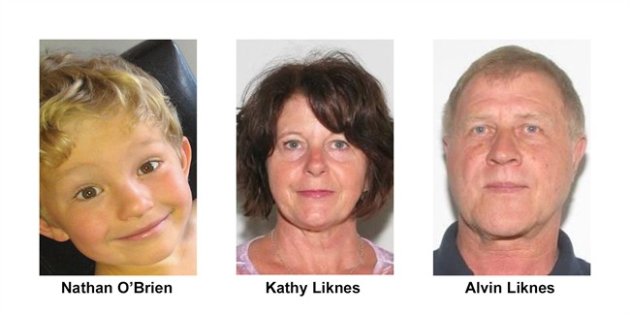Forensic investigators analyzing suspected homicides must trust that a dead body tells a story. When it comes to the Calgary slayings of five-year-old Nathan O'Brien and his grandparents, constructing that murder narrative to go to trial could be more challenging without any human remains.
"The bodies of the three victims have not been found," Calgary Police Chief Rick Hanson announced Monday, before adding that police nevertheless planned to bring three counts of murder against a suspect in custody.Though such cases are unusual, the absence of victims' bodies does not preclude a murder charge in Canada. A prosecution can still build a solid case, retired Toronto homicide detective Dave Perry said.
"It's not really about not having a body; it's about how much evidence do they have without a body," he said.
"You don't need the body for a conviction, but every case you work on, of course you want to get everything possible in terms of evidence."
Perry noted that convicted killers Michael Rafferty and Terri-Lynne McClintic, currently serving life sentences for murdering eight-year-old Tori Stafford, were arrested and charged in May 2009 — two months before the Ontario girl's remains were found and confirmed as being hers.
- TIMELINE | Tori Stafford murder trial at a glance
A Calgary judge in 1987 found Al Dolejs guilty of two counts of second-degree murder for killing his 12-year-old son Paul and 10-year-old daughter Gabi. Their bodies were not located until months after Dolejs was sentenced to life. He eventually brokered a prison transfer deal to lead investigators to his children's remains near Bragg Creek, and died in prison in 2005.
'The dead speak volumes'
In Florida, Casey Anthony was charged in connection with the 2008 murder of her two-year-old daughter Caylee. The girl's remains were located about two months after Anthony was charged, though she was eventually acquitted.
If Nathan's or the Likneses' bodies are ever recovered, Perry said, forensics teams would be looking out for everything from fibre evidence to DNA transfer from the suspect to the victims.
"That's the next next biggest hurdle for [Calgary police]," he said. "Finding those three bodies could net them additional forensic evidence and tell them a lot more about who was responsible."
That's a common refrain among criminology academics, said Janne Holmgren, an associate professor in the Department of Justice Studies at Calgary's Mount Royal University.
"We always say the body speaks volumes. The dead speak volumes," she said.
Investigators found blood inside the Liknes residence after the couple and their grandchild vanished on June 29. Police believe at least one person would likely have been in "medical distress" following what appeared to be a violent struggle. More than two weeks have passed since the trio vanished.
From this point, police would have to make an inference about the missing persons' fates.
No body, no prosecution in Thailand
"We know that people can only go on without so much amount of blood," Holmgren said.
"Based on that evidence, they would have been able to say that if those people didn't receive that urgent medical care, somebody died."
Although prosecutions for murder in countries such as Thailand can't proceed without a body, prosecutors in Canada can press ahead regardless.
"There have been successful prosecutions of people where the body was never found," Toronto criminal defence lawyer Michael Lacy said.
"If you think about it, that makes sense that you shouldn't necessarily need a body. Otherwise, everybody who's going to get away with murder would just make sure they dispose of a body, in acid or whatever."
Proving death is among the essential elements in the offence of murder.
"But I wouldn't want to suggest that that makes this a very difficult prosecution. It doesn't," Lacy said. "It really depends on other circumstances — a motive, for example, would be an important element of the Crown's case."
Types of murder charges telling
A motive could be materializing based on interviews with Douglas Garland, who is currently in police custody and charged with two counts of first-degree murder and one count of second-degree murder.
Police previously told reporters that Garland harboured "bad blood" with Alvin Liknes over a business feud.
The two types of murder charges in this case are also telling.
First-degree murder in Canada refers to a planned and premeditated crime.
"They have evidence an individual went to that house for the purposes of committing that crime," Holmgren said. "For the second-degree murder charge, the individual might not have known there was a little boy in this house, and didn't have the premeditated component to have planned that murder, but in the commission of committing the alleged [planned] crimes, the person is presumed to have also murdered the little boy."
More questioning of the suspect is to come. Garland will likely be confronted with evidence gathered so far and asked to respond to it, Holmgren said, adding she has been impressed by the speed of the investigation so far.
In the meantime, police say more than 900 tips have poured in as they continue to search hay fields on the outskirts of Airdrie, north of Calgary, for the bodies of Nathan and his grandparents.
"The hope is that they're found, but it could be that they're not found for a long time," Holmgren said. "That's all we can hope for in terms of closure for the family, if there is such as thing."
Also Read
You Might Like »
1 - 4 of 12




















No comments:
Post a Comment